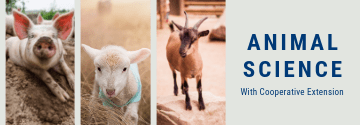Hay season is around the corner and many producers are likely greasing the wheels, sharpening blades, checking belt tension, and settling in for a long hay season. However, it may be wise to do some calculating and revisit some management decisions to determine hay needs and to see if there is a way to reduce hay needs. This could be important considering the tremendous cost of feeding cattle 365 days per year and knowing hay tends to be one of the most expensive feeds available.
In order to achieve the task of determining how much hay is needed and what the potential cost will be, Mr. Kevin Ferguson, Ms. Rebekah Norman, and Ms. Tammy McKinley developed an Excel based “Hay Calculator” to help with the calculations. That file can be found at https://ag.tennessee.edu/arec/Pages/decisionaidtools.aspx. The tool takes into account storage losses, feeding losses, bale size and weight, cattle weight, consumption, number of days fed, and hay price to determine hay needs and total cost. The calculator can also assist with hay quality analysis.
Based on several pieces of research, the method of storing and feeding hay significantly increase costs. Average storage losses for hay stored six months or longer range from 5 percent for hay in a barn to 30 percent for hay stored outside and uncovered. Hay stacked and covered with a tarp on a rock pad or pallets results in 12 and 14 percent loss respectively. Additional storage methods include a plastic sleeve and net wrap which result in average losses of 19 and 23 percent respectively.
Similar to storage, the method of feeding hay can influence hay loss. Feeding losses from feeding hay in a cone ring range from 2 to 5 percent while feeding hay in a conventional ring results in 4 to 7 percent hay loss. The use of a hay trailer generally results in 10 to 13 percent hay feeding losses while the use of a cradle will result in 15 to 20 percent losses. Unrolling hay on the ground has the most variability with losses ranging from 5 percent to 45 percent. Hay feeding losses are likely more a function of how much hay is fed at a time as opposed to the method. For instance, feeding a week’s worth of hay in a cone ring will result in more feeding loss than feeding one day of hay in a cone ring.
For illustration purposes, consider a producer with 30 cows averaging 1,200 pounds and feeding 2.5 percent of the cows body weight for 150 days. This would result in each cow needing 30 pounds of hay each day on a dry matter basis. Assuming 11 percent moisture would result in the herd needing 76 tons of hay or 152, 1,000 pound bales. If the bales cost $35 per bale then the total cost to the herd would be $5,320. However, storage and feeding loss have not been considered.
Now consider two management options with this herd: storing hay in a barn and feeding in a cone ring or storing net wrapped hay outside and feeding in a conventional ring. The first system of storing hay in a barn and feeding in a cone ring results in a total loss of 6.4 tons of hay or 13 bales of hay for an additional hay cost of $451 for the herd. The second system of storing net wrapped hay outside and feeding in a conventional hay ring results in a total loss of 21.6 tons of hay resulting in the need of 43 additional bales of hay and adding $1,513 to herd hay cost.
This basic illustration demonstrates changes in feed costs from differing hay storage and feeding management. Producers should consider methods of reducing hay storage and feeding losses to reduce total costs. Producers should also consider grazing management practices that reduce hay needs which have a potential of reducing feed costs.


